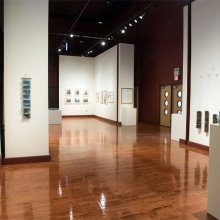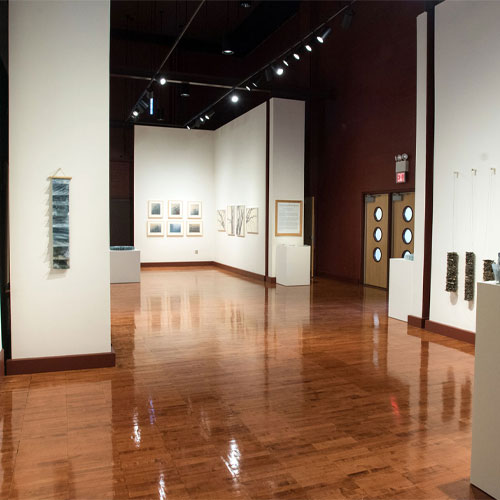

One of the chief reasons that Madelin Aho ’21 first chose to attend Westover was her interest in the School’s Sonja Osborn Museum Studies Internship (SOMSI) Program with Hill-Stead Museum in Farmington.
It didn’t matter that the program was only open to students during their junior or senior year at Westover. “When I entered Westover as a freshman,” Madelin recalled, “I said to myself, ‘This is what I am going to do.”
Madelin’s father, the artist Eric Aho, said his daughter’s intention to someday be a SOMSI intern was quickly shared with Ali Hildebrand, Westover’s Art History teacher and the advisor to the internship program.
“Ali knew it right away,” Eric recalled.
It seems fitting, then, that in the final weeks of the Aho family’s Westover experience, their love of art and art history was literally on display and shared with the School community.
On April 15 Madelin gave her presentation at the 13th annual SOMSI Symposium — an examination of the artistic vision of French Impressionist Edgar Degas by exploring one of his works, Jockeys, that is now part of Hill-Stead’s art collection. (To view Madelin’s presentation — “A Sight No Longer Connecting’: The Binocularity and Monocularity of Degas’ Perception in Jockeys” — go to here)
Meanwhile, this spring, Westover’s Schumacher Gallery is featuring “Oil and Silver,” an exhibition of paintings by Eric and photography by Rachel Portesi, Madelin’s stepmother. In addition, on April 28, Eric and Rachel gave a virtual, all-school presentation about their exhibition, their experiences as artists, and their sources of inspiration. Their exhibition was coordinated by Ali and by Photography teacher Caleb Portfolio, who serve as Co-Directors of the Schumacher Gallery.
On May 1, Eric and Rachel came to Westover to lead workshops as part of the School’s Mountain Day activities. In Westover’s Quad, Eric presented an “en plein air” workshop for interested students and faculty, who were then able to try their own hand at painting canvases. Meanwhile, Rachel led a group of students and faculty who wanted to learn how to create tintypes — a complicated and challenging early form of photography.
Madelin’s SOMSI Adventure
As a virtual student last fall at her home in Vermont, Madelin began her research on her SOMSI project on Degas and his pastel, Jockeys. She not only worked with Ali and Library Director Giselle Boyadjian “to compile sources from the Westover Library, the online library Jstor, and the Hill-Stead archives,” but was also able to take advantage of a resource closer to home — “my dad’s fairly extensive collection of Degas essays and catalog books — to gather more information.”
“Having more access to a broader spectrum of research methodologies,” Madelin added, “I was able to attain a much deeper understanding of Degas, and the intricacies of the time period.”
Degas, and the intricacies of the time period.”
Madelin’s interest in Degas goes back to childhood visits with her family to the Clark Art Institute in Williamstown, Massachusetts. “When my father would ask, ‘Who do you want to see?’ Degas would be on my list,” Madelin recalled.
Madelin can also still remember a visit to the Metropolitan Museum of Art in New York City, where a special invitation from the Curator of Prints and Drawings gave Madelin an opportunity to view Degas’ works on paper close at hand and without protective glass.
“It was the first time I was able to get really close to his works and see the pastels up close,” Madelin said, and the experience of examining Degas’ ballerinas, jockeys, and race horses just inches away made a deep impression on her.
Usually when one takes young children to art museums, Rachel said with a laugh, “you have to drag them. They just complain about it all the time that you are there. But Madelin was really comfortable in that world.”
Drawn by both her family connection to Westover — Madelin is the granddaughter of the late Marcia McCuaig Geer ’53 — and by her early and sustained exposure to art, it was not surprising that Madelin was won over by the School’s strong commitment to the arts and art history.
“I came in knowing the art world very well from one perspective — from the visual perspective,” Madelin said. She was used to looking at art and knowing what she liked, what appealed to her.
At Westover, though, Madelin soon felt “humbled” — in a good way. As she worked with Ali in her art history classes, Madelin found her perspective on art expanding. As a younger child looking at a work of art, Madelin said, “I had very little context at all. Ali gave me context — more specifically, the building blocks to interpret the context” of works of art, including works of art that she herself created.
In selecting Jockeys as the subject of her SOMSI presentation, Madelin had remembered first seeing it during her initial visit to Hill-Stead — originally the home of Westover’s architect, Theodate Pope — on a trip offered to new students at Westover.
Madelin chose the pastel not only because Degas was one of her favorite artists, but because she had been immediately drawn to the work and how it had been given a prominent place of display in the former home. Although Madelin also had considered at least two other artworks at Hill-Stead — a wood print by Mary Cassatt and a work by James Whistler — as the subject of her SOMSI project, she soon decided on Jockeys.
“Visually I loved it,” Madelin said. And over the course of her SOMSI research, “contextually, I learned to love it even more.”
Reflecting on Madelin’s SOMSI project, Eric said, “You hope as a parent that you can give your children what will help prepare them, and you wonder what they are going to do with the opportunity. It was wonderful to see Madelin wrap up her academic experience at Westover with that level of presentation.”
When his daughter looked at the works of Degas as a young child, he added, “she was engaged visually, but she couldn’t put it into words. Now,” he added, “she has engaged herself in a fuller way.”
“Madelin is really comfortable in the world of art,” Rachel said. “She is such a strong, smart, academic young woman. It was very moving for me to watch Madelin take command in her presentation.”
“Whatever she goes on to do,” Eric added, “her foundation is so strong. I am so proud that Madelin has had the opportunity to work with Ali, I’m certain her influence will be lasting, and that Westover could accommodate, even in the pandemic, her long-held interests.”
‘Oil And Silver’ In The Schumacher Gallery
For Eric and Rachel, their joint exhibition at Westover has a special distinction in their careers as artists — it marks the first time the two have ever had their work on display together.
In their joint artist statement for the exhibition, they noted, “Oil and silver are the fluid elements of our chosen mediums. For Eric, it’s colored pigment suspended, typically in linseed oil. Silver is the light-sensitive element in Rachel’s tintype photography. Different as they are, each is necessary to ‘fix’ images in place on the linen canvas or the metal photographic plate.”
“Our work couldn’t be more different,” they added. “We are not collaborators exactly, we are more like catalyzers for each other. We function independently with shared missions, hopes, and goals. This exhibition is a welcomed opportunity to affix two apparently contrasting aspects of our artistic lives.”
Rachel’s works, collectively entitled Hair Portraits, are “a series of 17 tintype photographs of female and femme-identifying models of varied ages and ethnicities who consider hair to be a large part of their identity,” Rachel wrote.
“The exhibition addresses fertility, sexuality, aging and mortality, vulnerability, and intergenerational trauma — as well as harmony and discord with nature.”
Rachel noted that “each tintype photograph in Hair Portraits is the culmination of hours I spend making a collaborative ‘hair sculpture’ with the model as the model stands against a wall. The subject’s hair is fastened to the wall itself with push pins, intricately intertwined with symbolic objects such as fresh flowers, twigs, large plant fronds, family heirlooms and mementos, and additional flora from my garden in Vermont.”
In her talk to the Westover community, Rachel noted that she had previously worked using Polaroid land cameras, but once Polaroid and later Fuji stopped making film, she turned to an old form of filmmaking: wet plate collodion tintypes — a time-consuming, involved process that nevertheless has renewed her excitement for making images.
Eric wrote that his paintings — which he created during the pandemic over the past year — “are vestiges of actual places, each unearthed, reshaped, and reconstructed in the studio, compelled by memory and invention. To stand and keep still in the woods even for a few moments is hard to do. It’s a little scary and, in our era of climate change, there’s a new heightened urgency to the experience. One of painting’s built-in mandates, as I see it, is to measure the rhythms of the year through an accumulated record of perceived nuance — a valuable form of witness.”
Eric noted that the exhibition that he and Rachel have assembled for the Schumacher Gallery is the result of “a conversation that has unfolded with Ali and Caleb over four years. We actually started to discuss it in the first few weeks that Madelin was in school at Westover. It has taken that much time to percolate.”
Their joint exhibition, Eric noted, “really expresses and underscores the work that Rachel and I have done over the past few years, much of which was accomplished while Madelin has been at Westover.”









